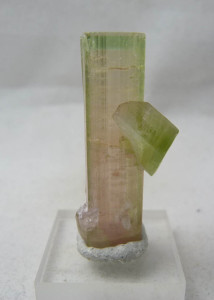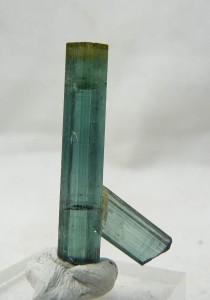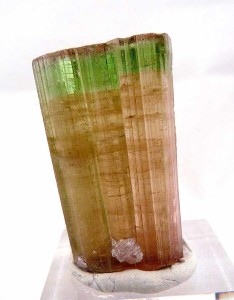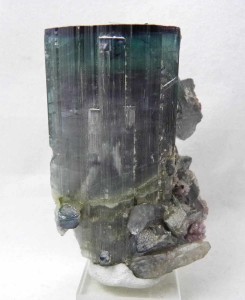Colored tourmaline has been known for hundreds of years but Elbaite as it is formally known was only proven to be a discrete mineral species with the advent of sensitive quantitative chemical analysis methods becoming available to analytical chemists in the early 20th century.
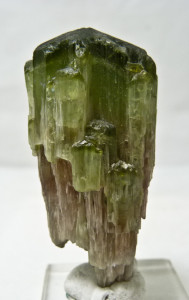 Elbaite has been found on every continent in gem quality crystals on every continent except Antarctica and all of the major elbaite locations producing collector grade specimens are hosted in lithium-rich pegmatites, though there are some minor occurrences in tin, tungsten, and/or molybdenum rich hydrothermal veins and a very small few in some unusual schists though these do not produce anything worth keeping as more than a reference specimen. Elbaite is always associated with felsic rocks and is never a component of mafic mineral assemblages. Mineralogically, elbaite can be found with many different species, as pegmatites are known to be diverse, but the most common associates are quartz, albite, lithian muscovite (pink or yellow lepidolite), beryl, spodumene, garnet, apatite, and columbite-tantalite. Elbaite is also found in pegmatites that can be rich in rare phosphate minerals. Elbaite was discovered originally in 1913 at Fonte del Priete; a pegmatite rich area around San Piero in Campo on the Italian island of Elba. Crystals from the type locality are highly sought after and still famous for their aesthetics. Though small (almost always under 2cm long), they form very glassy, euhedral, pristine pocket crystals. Elbaite from the type locality and the nearby pegmatites is typically pink, green, or blackish in color and crystals often have at least two differently colored zones. These elbaites are associated with quartz, albite, orthoclase, lepidolite, apatite, beryls, columbite, and oddly for a pegmatite locality, zeolites. A century after the discovery of elbaite, fine crystals are still being recovered from the type locality.
Elbaite has been found on every continent in gem quality crystals on every continent except Antarctica and all of the major elbaite locations producing collector grade specimens are hosted in lithium-rich pegmatites, though there are some minor occurrences in tin, tungsten, and/or molybdenum rich hydrothermal veins and a very small few in some unusual schists though these do not produce anything worth keeping as more than a reference specimen. Elbaite is always associated with felsic rocks and is never a component of mafic mineral assemblages. Mineralogically, elbaite can be found with many different species, as pegmatites are known to be diverse, but the most common associates are quartz, albite, lithian muscovite (pink or yellow lepidolite), beryl, spodumene, garnet, apatite, and columbite-tantalite. Elbaite is also found in pegmatites that can be rich in rare phosphate minerals. Elbaite was discovered originally in 1913 at Fonte del Priete; a pegmatite rich area around San Piero in Campo on the Italian island of Elba. Crystals from the type locality are highly sought after and still famous for their aesthetics. Though small (almost always under 2cm long), they form very glassy, euhedral, pristine pocket crystals. Elbaite from the type locality and the nearby pegmatites is typically pink, green, or blackish in color and crystals often have at least two differently colored zones. These elbaites are associated with quartz, albite, orthoclase, lepidolite, apatite, beryls, columbite, and oddly for a pegmatite locality, zeolites. A century after the discovery of elbaite, fine crystals are still being recovered from the type locality.
Chronologically speaking the next most significant discoveries of elbaite were made in the United States in New England, then California. The New England tourmalines are very spectacular and are internationally famous for their fine quality. The first occurrence in New England was made at Clark Ledge in Chesterfield, Massachusetts. This locality yielded fairly unremarkable elbaite by worldwide standards but is still important to note historically. It produced variously colored and sometimes bicolored prisms embedded in solid quartz matrix. The second discovery of elbaite in the United States occurred at Mount Mica in Paris, Maine in 1821 and was a very significant find. The site has produced a large quantity of fine tourmaline and still produces large pockets today, though it is very expensive to work. The pegmatites of San Diego and Riverside Counties in California have produced arguably the best elbaite in North America. The best specimens from the Himalaya, Tourmaline queen, and Tourmaline King mines in San Diego County are known for their large size, bright pink color, and distinctive green or blue pinacoidal terminations. Some of the finest specimens have nicknames such as the “Steamboat” or the “Candelabra.”
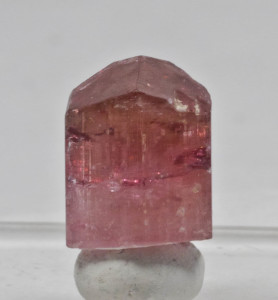 It is nowadays economically difficult to mine elbaite in the US and only a small trickle of new specimens appear yearly compared to how it was in the past. After mining elbaite became largely uneconomical in the U.S., it shifted to Brazil which has far greater reserves of the mineral. Most of the elbaite that comes from Brazil originates in the state of Minas Gerais. The principal mines that produce elbaite specimens and gem rough are Pederniera, Sapo, and Cruzeiro mines though there are many more that are smaller. The famous Jonas Mine of Minas Gerais produced over $55 million worth of beautiful cranberry colored elbaite from a single pocket. It is said that a person could easily stand up inside of it when it was emptied. The Paraiba region of Brazil is famous for a very rare and valuable copper rich variety of elbaite known as Paraiba tourmaline. This variety of tourmaline is neon blue to purple in color and is found as small crystals in softball sized pockets. A one carat flawless faceted Paraiba tourmaline is worth over $13,000.
It is nowadays economically difficult to mine elbaite in the US and only a small trickle of new specimens appear yearly compared to how it was in the past. After mining elbaite became largely uneconomical in the U.S., it shifted to Brazil which has far greater reserves of the mineral. Most of the elbaite that comes from Brazil originates in the state of Minas Gerais. The principal mines that produce elbaite specimens and gem rough are Pederniera, Sapo, and Cruzeiro mines though there are many more that are smaller. The famous Jonas Mine of Minas Gerais produced over $55 million worth of beautiful cranberry colored elbaite from a single pocket. It is said that a person could easily stand up inside of it when it was emptied. The Paraiba region of Brazil is famous for a very rare and valuable copper rich variety of elbaite known as Paraiba tourmaline. This variety of tourmaline is neon blue to purple in color and is found as small crystals in softball sized pockets. A one carat flawless faceted Paraiba tourmaline is worth over $13,000.
Much tourmaline is still mined from Brazil but most of it is from elsewhere in the world. Many nations in Africa produce fine elbaite specimens though it is rare to see any elbaite specimens on matrix from this continent. Among mineral collectors, Madagascar is the most famous nation in Africa for its elbaites, which are typically red to purple in color. Some of them have green or bluish terminations. Some very large, thick crystals with black exteriors and colorful, intricately zoned red, green, and blue interiors have been recovered. These kinds of crystals are typically sliced into many thin sections so the colorful insides can be examined. Nigeria produces the bulk of African tourmaline found in the gem trade, which is known for its cranberry red color. Some tourmaline from Nigeria has a swimming pool blue color due to copper, like Paraiba tourmaline and is very valuable. Mozambique has produced the odd crystal or two from the Alto Ligonha region though they, like the Nigerian specimens are rarely found on matrix. Namibia has produced many fine elbaite from the Karibib district which are found both on and off matrix. In Asia, the best known specimens of elbaite originate in Pakistan and Afghanistan though some beautiful elbaites have been found in Myanmar (Burma) as well. The many mines of the Himalayas have produced a dazzling array of different specimens. The most famous localities in this region are Stak Nala in Baltistan, Pakistan and the Paprok Mine in Nuristan, Afghanistan. Stak Nala typically produces very euhedral elbaite with a dark green, almost black body and transparent termination that grades from green at the bottom to red at the termination faces. Paprok is notorious for pink minerals- gem morganite, kunzite, rose quartz and bubblegum pink elbaite! Paprok mine’s elbaites are typically made from many crystals and can get quite large. Paprok has produced some indicolite too.
